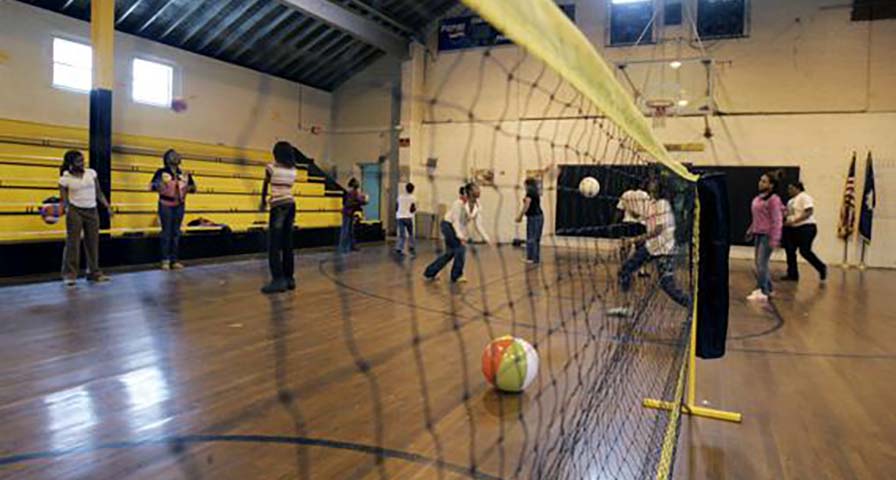Originally published Jan. 31, 2022 by The Bristol Cable.
By Joe Skirkowski
“Recently we’ve come to understand a lot more about the importance of sport and physical activity to overall health and mental wellbeing – but PE teaches much more than that,” says Andy Blackmore, Senior Project Manager at Wesport, a West Country-based advocacy charity. “It teaches children a lot about life – and as well as the physical there’s also the social and emotional development that comes with it.”
Scientific studies have linked physical activity with multiple psychological benefits including reduced stress and anxiety, and improved self-esteem, confidence, concentration and overall academic performance.
 But under Covid, children in 56% of primary and 37% of secondary schools nationwide have had time spent on physical activity – along with creative subjects – reduced, according to a recent report by the Department for Education (DfE).
But under Covid, children in 56% of primary and 37% of secondary schools nationwide have had time spent on physical activity – along with creative subjects – reduced, according to a recent report by the Department for Education (DfE).
The DfE’s School Recovery Strategies report looks at how schools have responded to the extraordinary challenges of the pandemic. It records how some have opted to cut down time spent on PE – as well as creative subjects, such as music and art – as they struggle to catch up on core learning missed over lockdown periods.
Over the 2020/21 academic year, students in England who were not children of key workers were forced to learn remotely between January and March. That followed a longer period of home learning for most children from March 2020 until the last couple of weeks of the previous academic year. Altogether, most school children in England have missed nearly two thirds of a school year’s worth of contact time over the pandemic, and that is without taking into account frequent two-week periods of isolation due to positive cases in class bubbles.
The report goes on to say that as the year progressed, both categories reported that “disparities in pupil’s social, emotional and academic progress increased” and that “pupils from disadvantaged backgrounds who did not attend school or engage well with online learning have been more profoundly impacted”.
While some schools bucked the trend and increased the time spent on PE, the capacity to do so was largely based on circumstance. Covid guidelines have also exacerbated the situation by making class mixing and sharing of equipment problematic.
There is no law stating how much PE a school is required to provide. DfE guidelines strongly suggest a minimum of two hours per week, on top of at least one hour’s playtime each day. While this advice is usually largely followed, schools ultimately have the autonomy to create their own timetables.
Despite extra government funding through the Primary PE and Sports premium, primary schools are disproportionately represented when it comes to those cutting down on PE. There are a number of reasons for this but the report goes on to state that primary leaders view the gaps in progress between students, especially in basic literacy and numeracy skills, as the biggest challenge they currently face.
The new revelations about reduced PE hours have sparked concerns among advocacy groups such as Blackmore’s, which claims children are missing out on more than just exercise.
“Sports can help young people understand what it means to be part of a team and about respecting colleagues and opponents,” says Blackmore, whose charity encourages schools and workplaces to engage in more sports and physical activity. “But mainly it’s about personal development, building resilience and learning how to be a decent person.”
PE isn’t just a ‘nice to have’
“The fact of the matter is that a lot of schools view subjects like PE as an add-on, and I can understand why they would want to focus on core subjects like maths and English because they’re under huge pressure,” says Blackmore. “But there is an increasing understanding that physical and sporting activity leads to higher academic achievement and heightens whole-school performance – I think schools need to take this into consideration when they think about cutting time spent on PE.”
Studies have shown that there is a link between physical activity and fitness and improved memory and attention spans. Perhaps ironically, the type of subjects that are thought to benefit most from this trend involve reading and mathematical skills. While schools have tough choices to make, Blackmore was keen to stress that there are cost effective and time efficient options available, such as the daily mile scheme, that can provide children with extra physical activity.
“The pandemic has been hard for everyone,” Blackmore goes on, with fewer schools using Wesport’s services than before the pandemic. “However, it’s not just a school’s responsibility to get children exercising, there are plenty of sports clubs out there and building that link between education and community is really important.”
“Unfortunately, there’s not one quick fix to this problem; it’s partly about the government taking it seriously, but it’s also up to parents to help their kids be physically active outside of school where they can, we all have a responsibility.”
Boost Student Wellness with the IHT ZONE heart rate monitor:




